![]()
The M113A1 Family of Vehicles In Australia Part 1 - Trials and Procurement
by Paul D. Handel
|
|
|
|
The FV 432 W14 at speed over dusty ground. A temporary duct was fitted to enable relatively clean air to be drawn into the vehicle, as the side-mounted air filter clogged very quickly and rapidly reduced ventilation. |
A number of delays contributed to the late start of the trials: the M113 vehicles landed in Sydney from the USA and were not available in Brisbane until 11 October 1962, whereas the FV 432 vehicles arrived in Brisbane in mid-September; the M113s were fitted with radios in Brisbane (Northern Command Workshops) and thus the special train with the armoured vehicles did not arrive in Innisfail until mid November; and the main body of A Sqn 2/14 QMI were not available due to their participation in Exercise Nutcracker until mid December.
![]()
Two each of the UK and US vehicles were trialled.
The FV 432 vehicles were still in the prototype stage, although both vehicles were stripped and rebuilt, to the most recent trials standards, at the Fighting Vehicle Research and Development Establishment (FVRDE) Chertsey, prior to their shipment to Australia. Both were fitted with the Rolls Royce B81 series petrol engine, an in-line 8 cylinder unit. The first vehicle, UK Registration 03DA17, was identified by the number W1 during the trials. It had been configured as APC with radio set configuration C42/B47, but its hull had been drilled to a four stretcher ambulance kit. The second vehicle was registered 03DA10 and was configured in the command role with C42/B47 and C11/R210 radio sets. A trial air conditioning unit to be fitted to one vehicle, plus new tracks, were delivered later.
The M113 vehicles were purchased by Australia, direct from the manufacturer, the Food Machinery and Chemical Corporation (FMC) of San Jose, California, with the assistance of the US Government. Both vehicles were new from the production line and were fitted with the Chrysler V8 petrol engine. The first vehicle carried the Australian Registration Number (ARN) 115421 and was identified as U1 during the trials. The second vehicle had the ARN 115422 and was identified as U2 during the trials.
Two RAEME artificers had received training in the repair and maintenance of the respective vehicles. One, WO1 D.D Horsley, had been attached to FVRDE in the UK to become familiar with the FV 432 series, whilst WO1 E.J. Richards was attached to a number of US establishments. In addition, an RAAC sergeant, J.S. Barker, had been attached to US establishments for training in driving and servicing aspects of the M113. These personnel also provided driving and servicing instructions to the crews from A Sqn 2/14 QMI, both in Brisbane and later in North Queensland.
![]()
The trials included operation of the vehicles in jungle terrain, swimming capabilities and storage in hot/wet conditions, operation in hot/dry conditions with dust and rocky terrain, as well as a long distance drive from Mount Isa to Innisfail.
Physiological tests were conducted on soldiers carried in the passenger compartments of both types of vehicles. These included battle efficiency tests as well as medical testing after being closed down inside the vehicles for specified periods of time.
At the conclusion of the trials, several reports were prepared. The UK naturally prepared their own report, whilst ADE prepared a report comparing the two types of carriers. Some of the key features in the Australian report led to the adoption of the M113 as the tracked armoured personnel carrier of the future.
|
|
|
The FV 432 W14 moving over sandy terrain. |
Some of the points made when comparing the vehicles and their performance were:
The M113 exceeded the cross country performance of the FV 432 in all types of terrain.
The power to weight ratio of the M113 was about 25% higher than that of the FV 432.
The radius of action of the M113 was less than that of the FV 432.
The FV 432 was superior in crew comfort to the M113 and better ventilation for the personnel compartment was provided.
The ease of maintenance was in favour of the M113.
The report recommended the purchase of the M113 vehicle as being the most suitable of the two types trialled.
![]()
As early as March 1963, the Ordnance Division of the FMC Corporation had provided a budget proposal to supply 103 vehicles to the Australian Army. The trials report was not produced until May 1963, and FVRDE did not complete their own report on the trials of the FV 432 until August 1963. Despite these activities, the evaluation process proceeded for most of 1963, although it appeared to have been always in favour of the M113.
The Army’s two main concerns were with the weapons station and the ventilation system. Various questions were asked of the US Army, which had been developing different types of cupolas, but not necessarily specifically for the M113. In the end as no satisfactory paper solution was forthcoming, the standard cupola was purchased.
The change to diesel engine by the US Army in the standardised version, the M113E2 (subsequently to M113A1), did not seem to worry the evaluation process, particularly as the engine, a GM 6V53, promised longer range, better low speed operation, and of course lessened the fire risk associated with petrol engines in armoured vehicles.
The lack of ventilation in the passenger compartment when closed down was a significant point made in many of the trials notes. A modification was proposed which provided a filter box on the rear cargo hatch, and a blower unit which forced air into the passenger compartment. The filter was accessed from outside the vehicle, and the extra weight of the hatch was compensated for by the provision of a torsion bar on the hinge mechanism. The rear hull top of the Australian vehicle would thus be different from the US vehicle, including omission of the ventilation dome and the bump stops for the cargo hatch being higher due to the size of the filter box.
|
|
|
M113 U1 climbing a slippery jungle road |
Foam padding inside the hull of the Australian vehicle was another addition.
It would appear that first orders for the M113A1 from Australia were let in 1964. Upon entering service with the Australian Army, the M113A1 vehicles carried 6 digit ARNs with the prefix 134. The first vehicle to be so numbered was 134140.
First vehicles arrived in Melbourne in early 1965, and these were issued mainly to the Armoured Centre at Puckapunyal for crew training and a small number to the RAEME Training Centre at Bandiana for training of RAEME Tradesmen. One regular unit, A Squadron, 4/19th Prince of Wales Light Horse, was the first operational unit to be equipped with the new vehicles.
Training had barely commenced on the new equipment when the government announced that Australia would commit an infantry battalion to the conflict in South Vietnam, and that it would be supported by armour.
The carriers had barely entered service and they were going to be taken to war.
![]()
The photos accompanying this article are all from Australian and United Kingdom official sources.
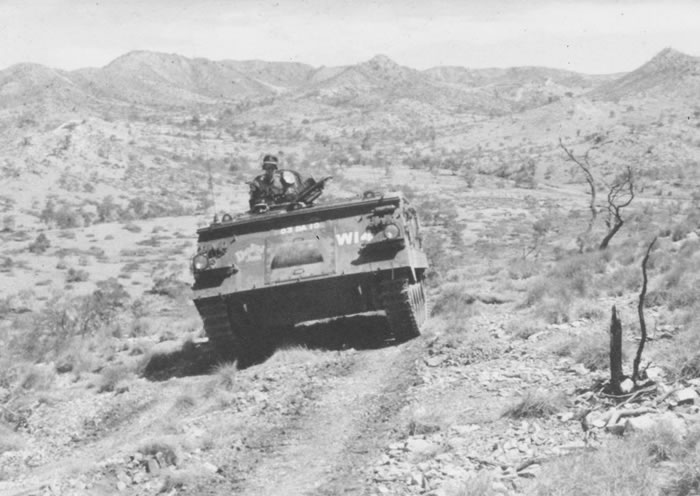
Climbing a rocky hill during the Mt Isa portion of the trials is FV 432 W14

FV 432 W1 is fording a fast running creek during jungle trials
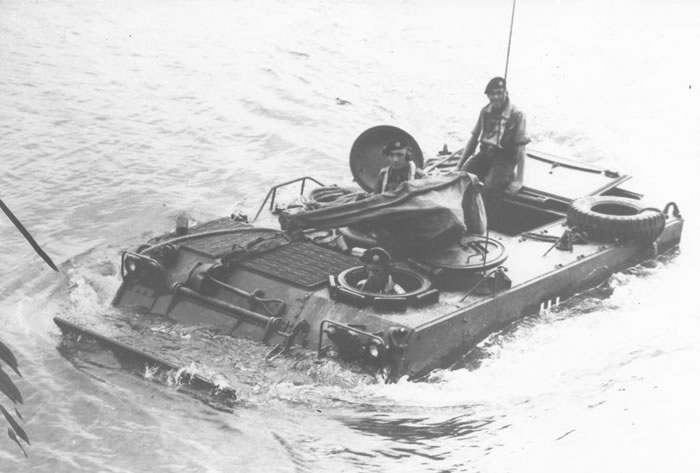
M113 U1 swimming in Mourilyan Harbour. The “trim vane” is deployed at the front of the vehicle. Unlike the FV 432 which used a wading screen, the M113 could be prepared for water entry relatively quickly.

M113 U2 climbs a rocky hill. The .50 inch machine gun is mounted on the commander’s cupola, and is covered with a canvas cover to keep the weapon clean.
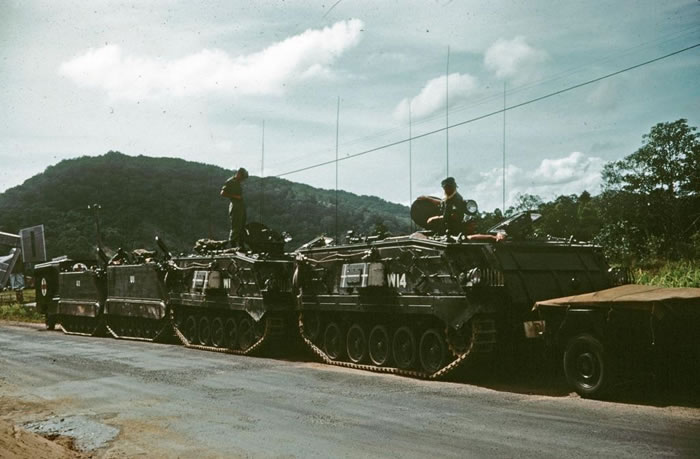
A convoy comprising both FV432 vehicles, both M113 vehicles and a Landrover Ambulance, parked by the roadside. The wading screens stowed around the hull top on the FV 432 vehicles as well as the cluttered exterior contrast with the clean sides of the M113s.
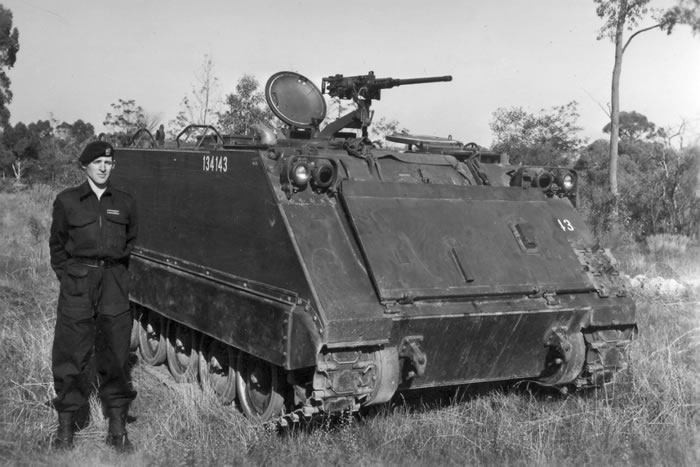
A staged photo showing a new vehicle, with both commander’s and driver’s hatches open and the .50 inch machine gun mounted on the cupola. In 1965 the black tank suit was worn by RAAC crewmen. The position of the ARN on the side and the front left of the hull may be seen.
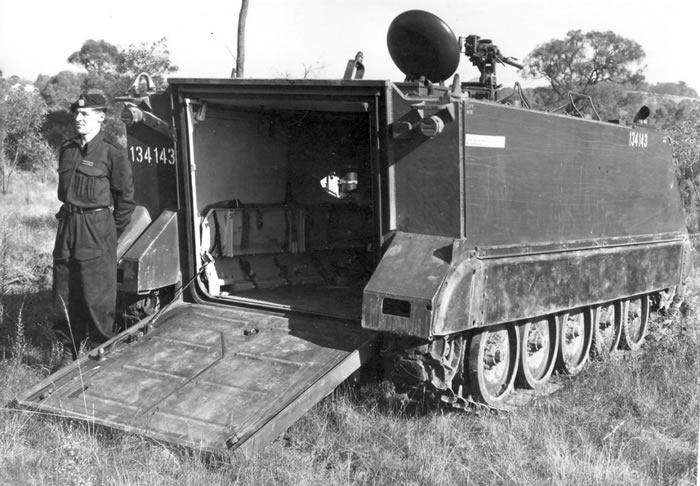
The rear of the vehicle with ramp lowered and interior passenger compartment seats in the stowed position. The large bump stop for the cargo hatch can be seen on top of the vehicle hull on the right hand side. The original integral fuel tank is located on the left side of the vehicle, just inside the ramp.

Swimming the M113A1 was very common during training. The white marks on the hull side show the vehicle’s freeboard. In this view the ventilation filter box can be seen on the cargo hatch to the rear of the commander.
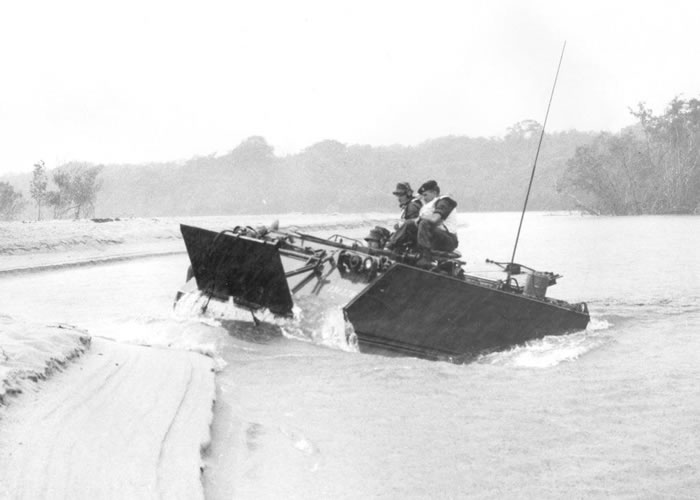
This M113A1 is exiting the water after swimming trials. The trim vane is deployed and the vehicle tow rope is held in place over the trim vane by a rope secured to the crew commander’s position. During early training, it was common to have the instructor sit on the driver’s open hatch.

M113A1 ARN 134251 during student driver training. The machine gun is fitted, and trainees awaiting their turn in the driver’s seat sit around the open cargo hatch.

An M113A1 of the Armoured Centre, with trainees posing in the driver’s and commander’s positions. This view shows the vulnerable position of the commander behind the machine gun. Turn indicators are now fitted below the headlight clusters in order to comply with the operation of the vehicles on Australian roads.
![]()
Article Text and Photographs Copyright ©
2015 by Paul D.
Handel
Page Created 25 April 2015
Last Updated 25 April, 2015
Back to Anzac Steel Main Page